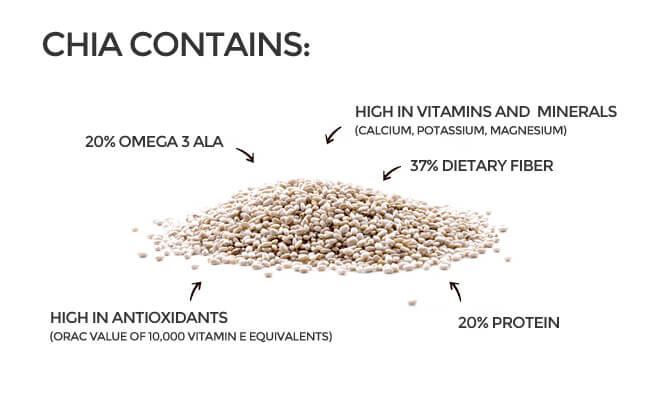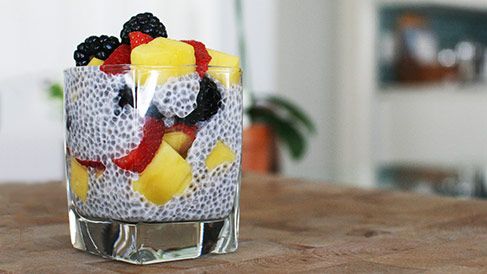Are chia seeds really that healthy?
What is or are chia anyway? And are they as healthy as all that?

Chia is an ancient crop, native to the tropical and sub-tropical valleys of Central and South America, namely in the countries of Mexico, Bolivia, Argentina, Ecuador and Guatemala.

According to AncientGrains.com, the Aztecs are the first recorded culture to utilize the chia seed as “an edible component of their diets,” about 3500 B.C. The word “chia” means “strength” in Mayan, an apt description to the nutrient value of this tiny seed.
In pre-Columbian civilizations chia was an essential ingredient in native medicines — chia can be ground into flour and pressed into an oil. The seeds stay edible for two to four years without refrigeration. In the 1500s, Spanish conquistadores repressed many indigenous traditions, and the use of chia was almost eliminated. However, it persevered in regional areas in Mexico, and in the early 1990s North and South American scientists, nutritionists, and agriculturalists rediscovered chia. Today chia is cultivated throughout the world, including Ecuador, Argentina, Mexico, Peru, and Bolivia but the world’s leading producer? Australia!
Is chia a ‘superfood’? That’s a nonsense term, but chia is super-nutritious. Including chia seeds in your daily diet won’t undo a regular intake of burgers and fries, but chia seeds are an excellent source of fiber, vitamins and minerals. Typically black or white in color, black chia seeds look like poppy seeds and since they are not a grain, they are gluten-free.

Chia is tops in nutrition
Healthy fats: Chia is one of the richest plant sources of polyunsaturated alpha-linolenic acid (ALA), an omega-3 fatty acid that’s linked to a reduction in inflammation and enhanced cognition. ALA is an essential fatty acid, which means we need to obtain it from food sources.
Complete protein: Chia seeds contain all the essential amino acids, and one tablespoon contains about three to four grams of protein.
Minerals: Just two tablespoons of chia seeds contains 18 percent of the Daily Recommended Intake (DRI) for calcium, 35 percent for phosphorus, 24 percent for magnesium, and about 50 percent for manganese. These nutrients are linked to healthy blood pressure and are important nutrients for DNA synthesis.
Satiety and weight management:
Chia seeds are unique in their ability to absorb as much as 12 times its weight in water. Soaking the seeds transform them into a lovely, gelatinous gel, full of soluble fiber that slows digestion and increases fullness. The Harvard School of Public Health reports that these soluble fibers may help lower LDL cholesterol and promote stable blood sugar.
Top chia tips:
Unlike flaxseeds (that should be eaten ground up to be nutritionally available), chia seeds are delicate and easily digested so they can be sprinkled on your food or eaten soaked.
To soak:
Using a ratio of 1/3 cup chia seeds to 2 cups of water: take a mason jar, add water, add seeds and thoroughly stir or shake for 2 minutes, and refrigerate overnight. Forgot to soak? When you’re ready to eat, just swish the chia and water in the sealed mason jar for about five minutes and let sit for another 5-10 minutes, and you’ll have a decent chia gel. Watch chia seeds expand here.
More flavor and nutrition! Soak chia in fresh coconut water, almond, soy, or coconut milk, or 100 percent (unsweetened) juice, unsweetened yogurt, oatmeal, or soup. If you like a sweeter taste, add your own honey or sugar.

More ideas adapted from the Academy of Nutrition and Dietetics:
- Use chia gel to bind veggie patties or as a thickener in soups.
- Mix ground chia into flour to boost nutrients in baked goods like muffins, cookies and cakes.
- Soaked and hydrated chia can add fluffiness to gluten-free menu items like waffles and pancakes, too.
- Egg substitute: makes a great vegan substitute in egg-free baked goods. Click here for the recipe.
- com also has a bunch of great ideas.
Stored in the fridge, with a tight-fitting lid, for several months.
Ground chia seeds should be placed in a container with a tight-fitting lid, and may also keep a month or more. Chia gel keeps for about two weeks in the fridge.
Buy sustainably grown (without herbicides or pesticides) or “organic” chia (there are some USDA-certified growers in Latin America – check the label). In Cuenca, buy them everywhere, from Supermaxi, to Coral, or natural food stores throughout the city.
How much chia should you eat daily? Depends on you, your diet, and how much fiber you’re eating daily. Since chia is full of soluble fiber, be sure to add sufficient fluid as well, or else there’s a possibility of digestive upset. There’s a case reported of a patient who ate dry chia seeds immediately followed by a glass of water. The seeds expanded in the esophagus and caused a blockage.
One ounce, or about 2 tablespoons, has about 136 calories, 4.6 grams of protein, 8.6 grams of almost all unsaturated fat, and 11.8 grams of carbohydrate, almost all from fiber (9.6 grams.)
Please note:
Allergic possibility: If you are allergic to sesame or mustard seeds, avoid chia seeds. Regular chia seed intake is associated with a possible reduction in blood sugars and blood pressure, so if you have a history of diabetes, or if you’re taking blood pressure medications or blood thinners, monitor your blood glucose and speak with your physician before beginning to include chia seeds in your diet.
Easy Chia Pudding
Adapted from WellnessMama.com, this recipe takes just 10 minutes. Serves 4.
Ingredients:
2 cups liquid: your unsweetened milk of choice, either dairy, coconut, almond, or soy
½ cup chia seeds
½ teaspoon vanilla extract
¼ teaspoon almond extract (optional)
¼ cup (or less) of maple syrup, honey, or agave syrup
Instructions:
In a blender, process all ingredients on high for 1-2 minutes until smooth. Pour blended mixture into a glass jar, seal and refrigerate for at least 4 hours, or overnight. It will be thick and delicious. For more ‘crunchy’ pudding put all ingredients into a glass jar and shake for 5 minutes and refrigerate.
Feel free to add other flavors, such as a sprinkle of cinnamon, organic cocoa, or coconut and/or coconut extract.
Nutritional information made with 1 percent milk and maple syrup: per serving: 274 calories, 7.3 g fat, 0.8 g saturated fat, 57 mg sodium, 383 g potassium, 10 g fiber, 29.8 g sugar, 42.5 g carbohydrate, 15.8 percent DV vitamin D, 17.1 percent DV calcium, 65.1 percent manganese, 14.3 percent DV zinc.
____________________
Sources:
Beyond the Equator. About chia.
Food & Nutrition (Academy of Nutrition & Dietetics). Chia seeds: tiny seeds with a rich history.
Harvard T.H. Chan School of Public Health. Chia Seeds.
WebMD.com. Chia.






















